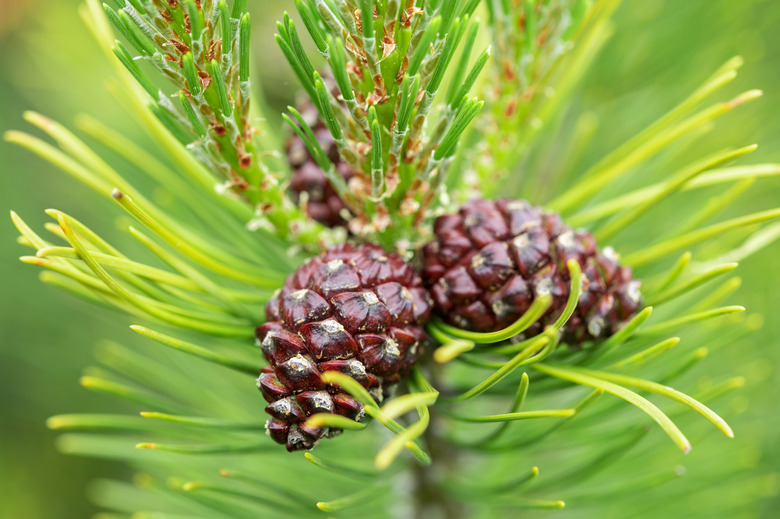Do Gymnosperms Produce Flowers & Fruit?
Gymnosperm means 'naked seed,' which refers to the fact that plants in this group do not produce fruits around their seeds. Instead, their seeds are protected by cone-shaped objects, such as the pine cones on an evergreen tree.
Gymnosperms also do not produce flowers, but they are thought to be the ancestors of angiosperms, which are flowering plants. Originating about 319 million years ago, gymnosperms include members of four plant phyla: Coniferophyta, Cycadophyta, Ginkgophyta and Gnetophyta.
Gymnosperms vs. Angiosperms
Gymnosperms vs. Angiosperms
The main difference between gymnosperms and angiosperms is that angiosperms produce fruits and flowers, and gymnosperms do not. The naked seeds of gymnosperm species are often held within cone-shaped objects.
While there are over 300,000 species of flowering plants, or angiosperms, there are only about 1,000 species of gymnosperms. Angiosperms are the most diverse group of plants, including everything from tiny duckweeds to giant redwoods.
Both angiosperms and gymnosperms live on land, and both use pollen for reproduction. The pollen of gymnosperms is usually dispersed by the wind, while many angiosperm species have developed strategies to attract pollinators to help disperse their pollen.
In terms of age, angiosperms appeared on the planet much more recently than gymnosperms. The fossil record dates the earliest gymnosperms to 319 million years ago, and scientists believe the first angiosperms emerged about 150 million years ago.
Types of Gymnosperms
Types of Gymnosperms
There are about 1,000 species of gymnosperms belonging to four plant phyla. These phlya are Biology(OpenStax'>Coniferophyta, Cycadophyta, Ginkgophyta and Gnetophyta/5%3A_Biological_Diversity/26%3A_Seed_Plants/26.2%3A_Gymnosperms).
Of these four phyla, species belonging to Coniferophyta are most abundant today. Species in the phylum Coniferophyta are also called conifers. With needle-like leaves, most species are evergreen and produce cones to protect their seeds. The conifers include plants commonly referred to as pines, spruces, firs, cedars, sequoias, yews, larches and tamaracks.
The second phylum, Cycadophyta, includes palm-like plants that grow primarily in the tropics and subtropics. Like conifers, the cycads also bear seeds within cone-like structures.
Ginkgophyta, the third phylum of gymnosperms, includes only one living species: Gingko biloba. Also known as the gingko tree, this species produces male and female sexual structures on separate plants. Different from most gymnosperms because it does not make cones, this species bears seeds within fruit-like structures called sarcotestas – but sarcotestas are technically fleshy seed coats, not fruits.
The fourth phylum of gymnosperms is called Gnetophyta. There are three genera within this group, with about 70 species living on the planet today. Abundant in the fossil records, the gnetophytes are believed to be the closest ancestor of today's angiosperms.
Cone-Shaped Objects
Cone-Shaped Objects
The reproductive structures of gymnosperms are as diverse as the species that produce them. Bearing male and female cones, most gymnosperms are wind pollinated, and self-pollination is uncommon.
Taking a pine tree as an example, the alternation of generations in a conifer is apparent. The mature tree is the diploid sporophyte, while the haploid gametophytes are produced within the pine cones. Pine trees are monoecious, meaning that they produce separate male and female cones on the same tree. Typically, the female cones are larger and located near the top of the tree, and the smaller male cones grow in the lower branches of the pine tree.
Male pine cones produce pollen grains through meiosis, and female cones produce ovules. When pollen is carried by the wind from a male pine cone to a receptive female pine cone, the process of pollination may begin. After an egg in an ovule of a female pine cone is fertilized by a pollen grain, a seed begins to develop.
Once it is ripe, this seed will be dispersed when the female pine cone falls from the parent tree, and if conditions are favorable, the seed will germinate and grow into a mature pine tree, and the conifer life cycle will begin again.
Cite This Article
MLA
Sloane, Christina. "Do Gymnosperms Produce Flowers & Fruit?" sciencing.com, https://www.sciencing.com/do-gymnosperms-produce-flowers-fruit-13428148/. 30 September 2021.
APA
Sloane, Christina. (2021, September 30). Do Gymnosperms Produce Flowers & Fruit?. sciencing.com. Retrieved from https://www.sciencing.com/do-gymnosperms-produce-flowers-fruit-13428148/
Chicago
Sloane, Christina. Do Gymnosperms Produce Flowers & Fruit? last modified March 24, 2022. https://www.sciencing.com/do-gymnosperms-produce-flowers-fruit-13428148/
